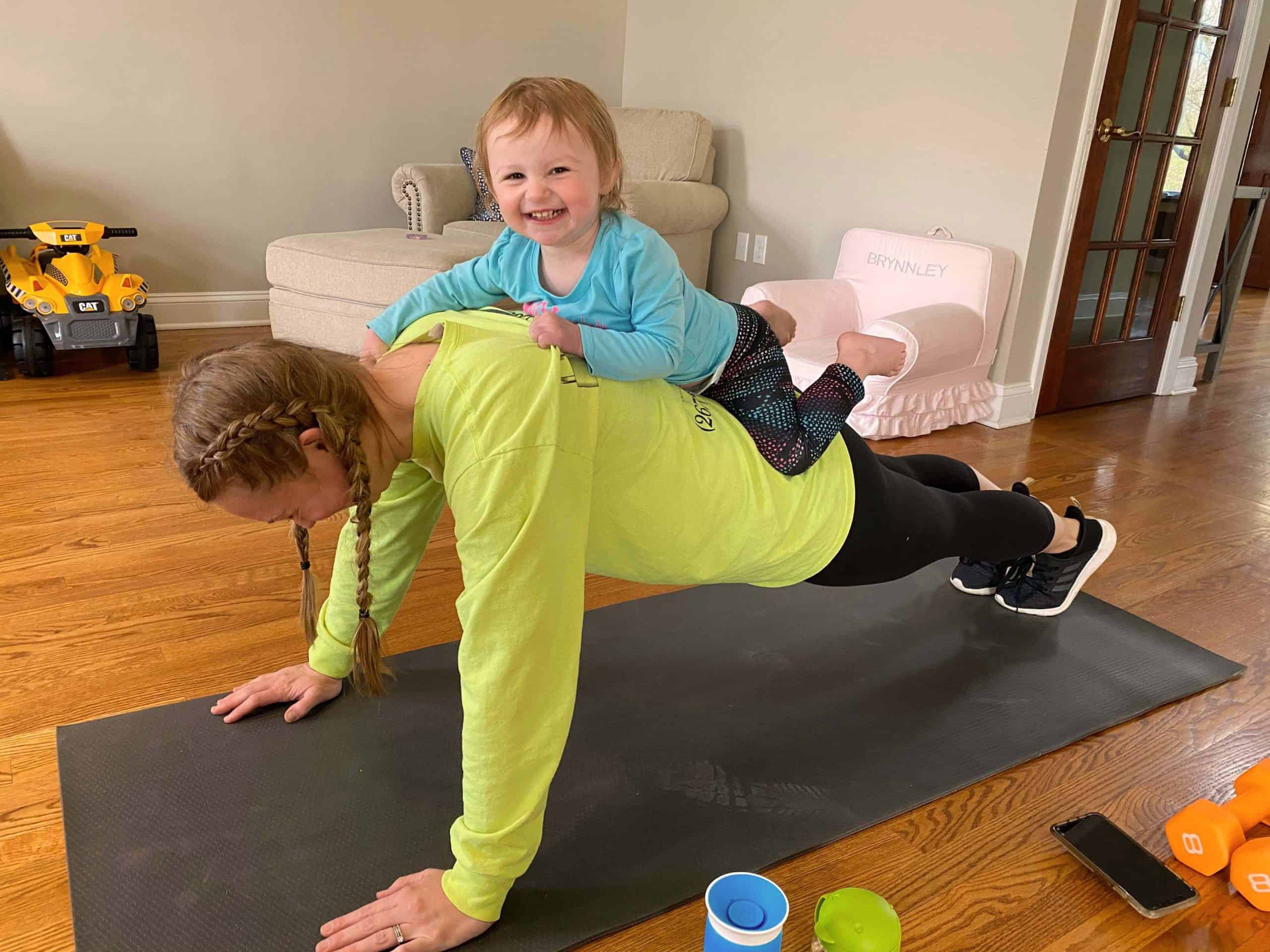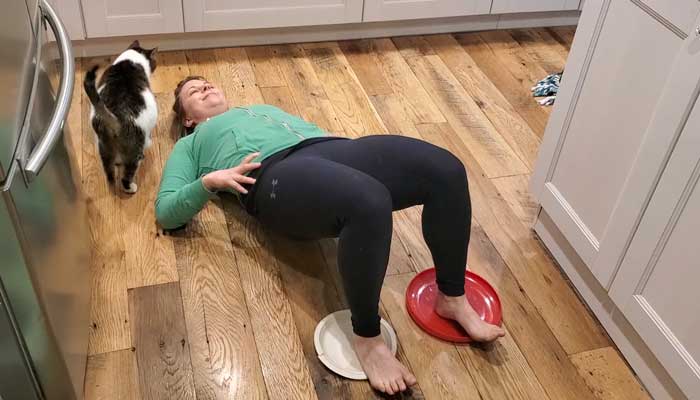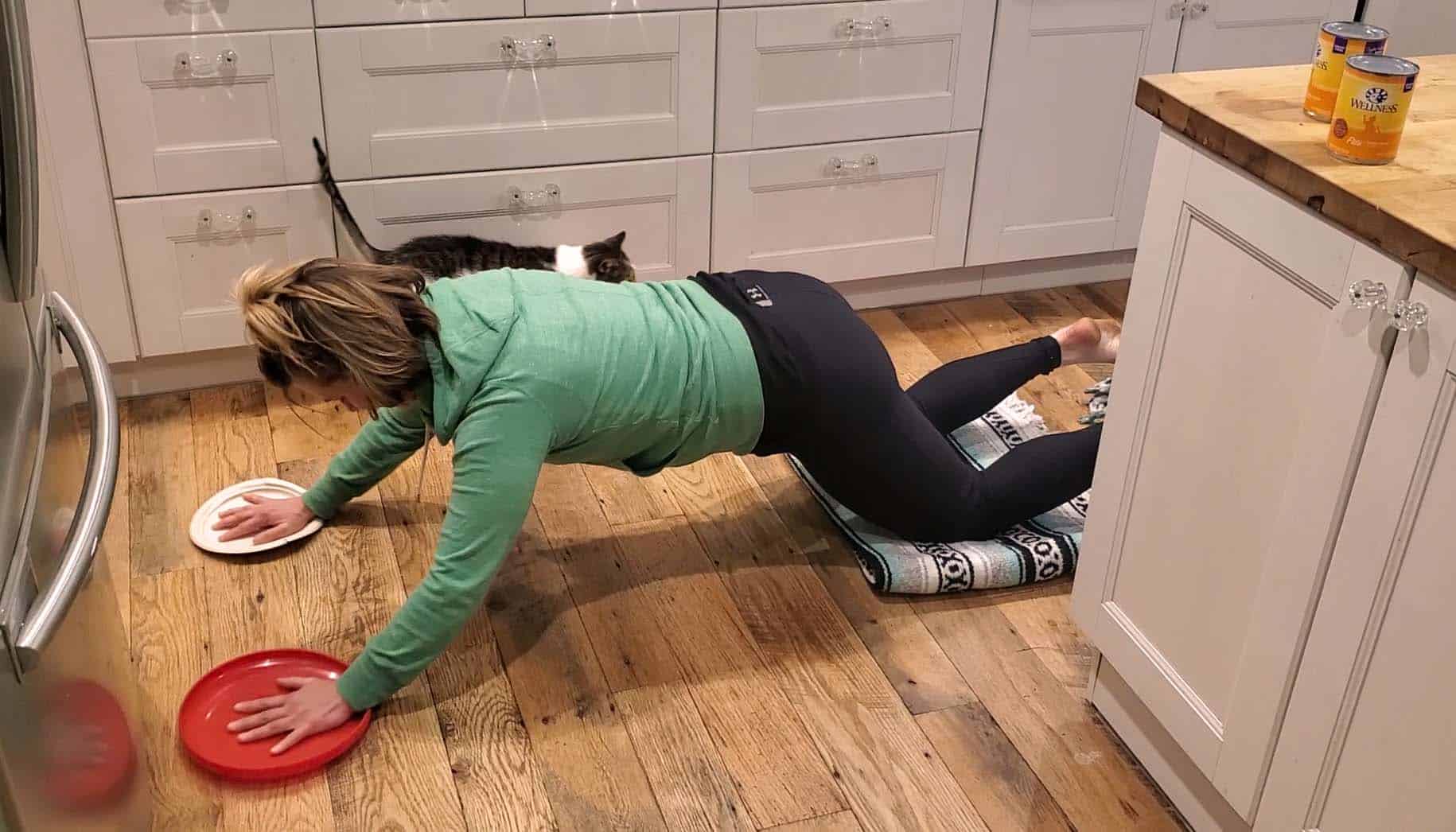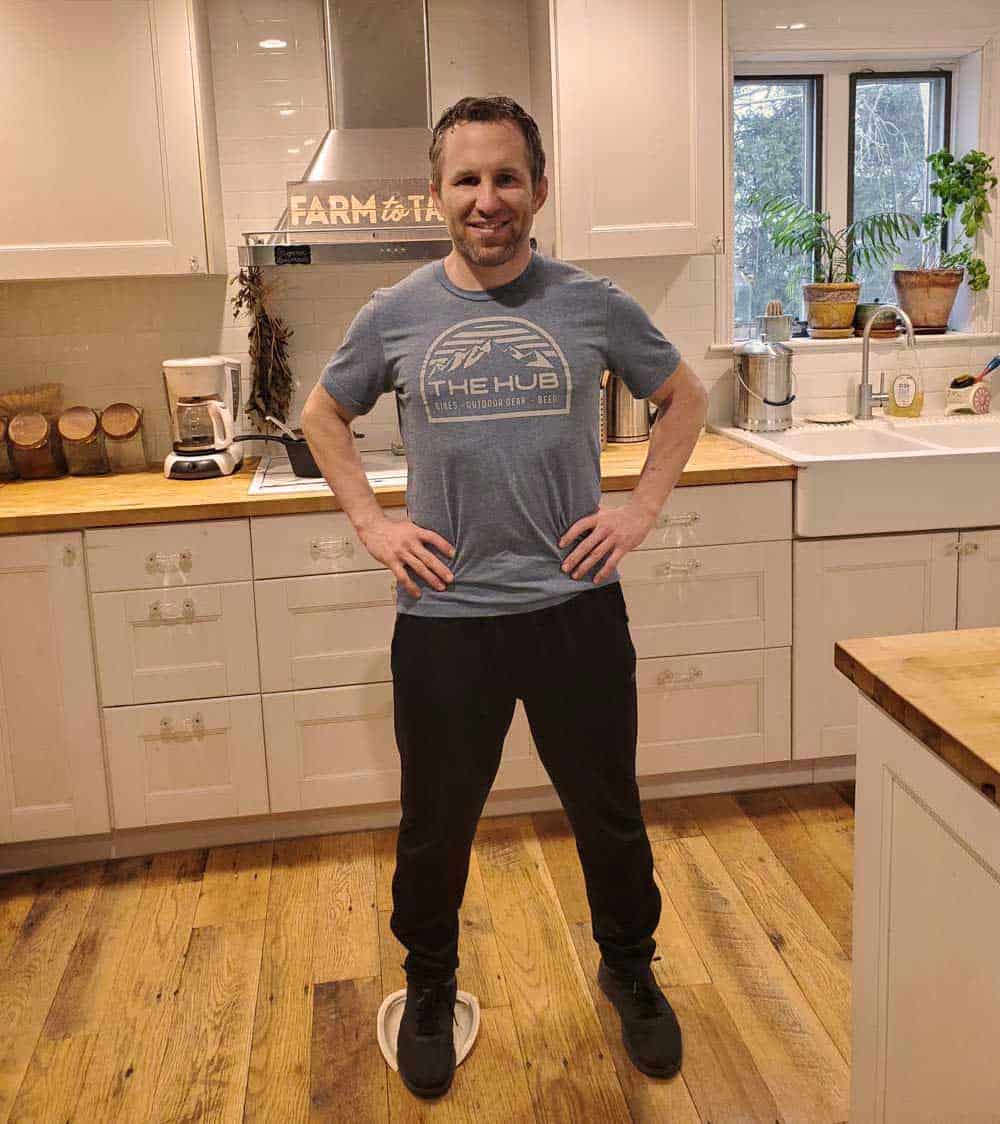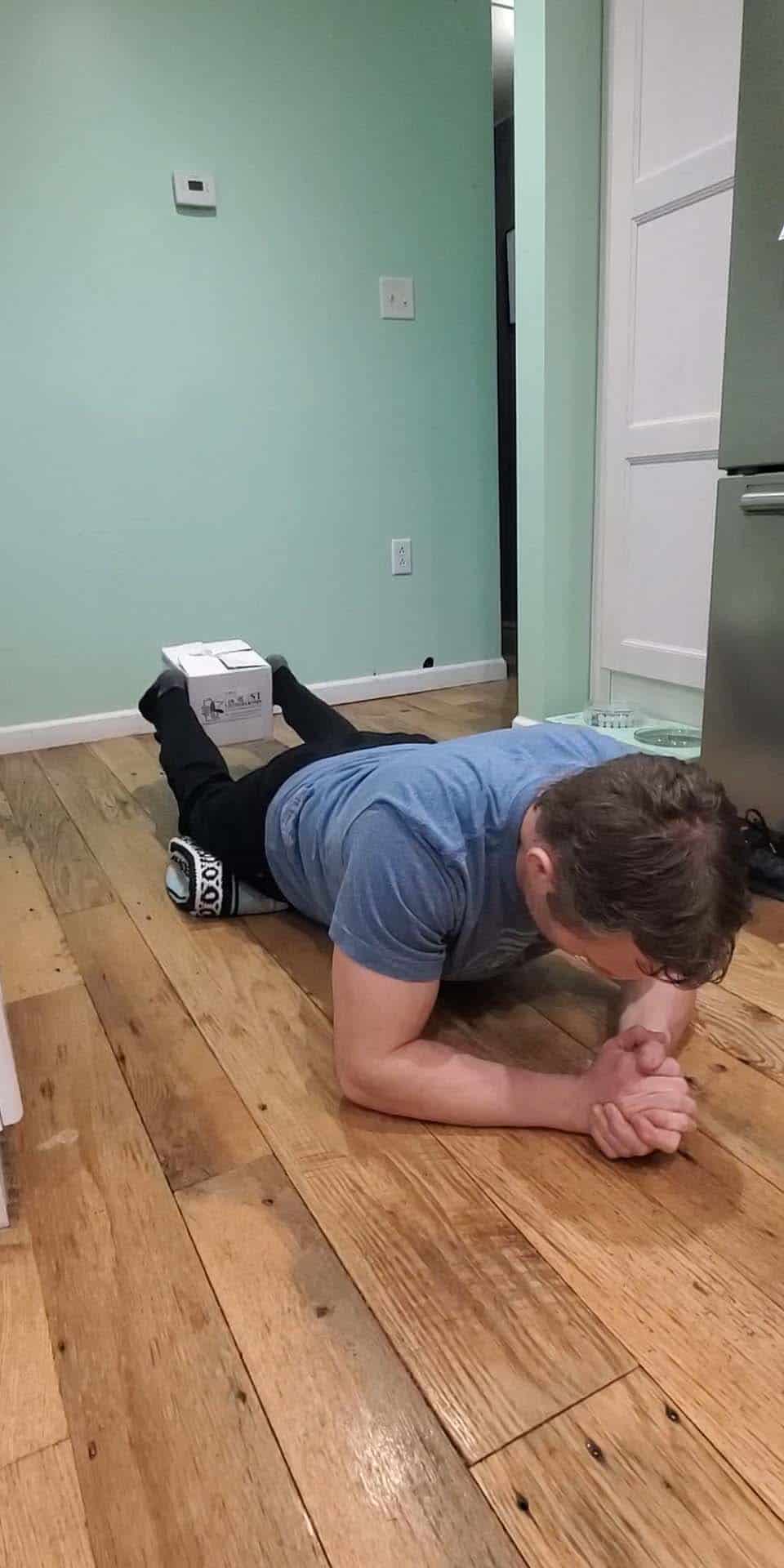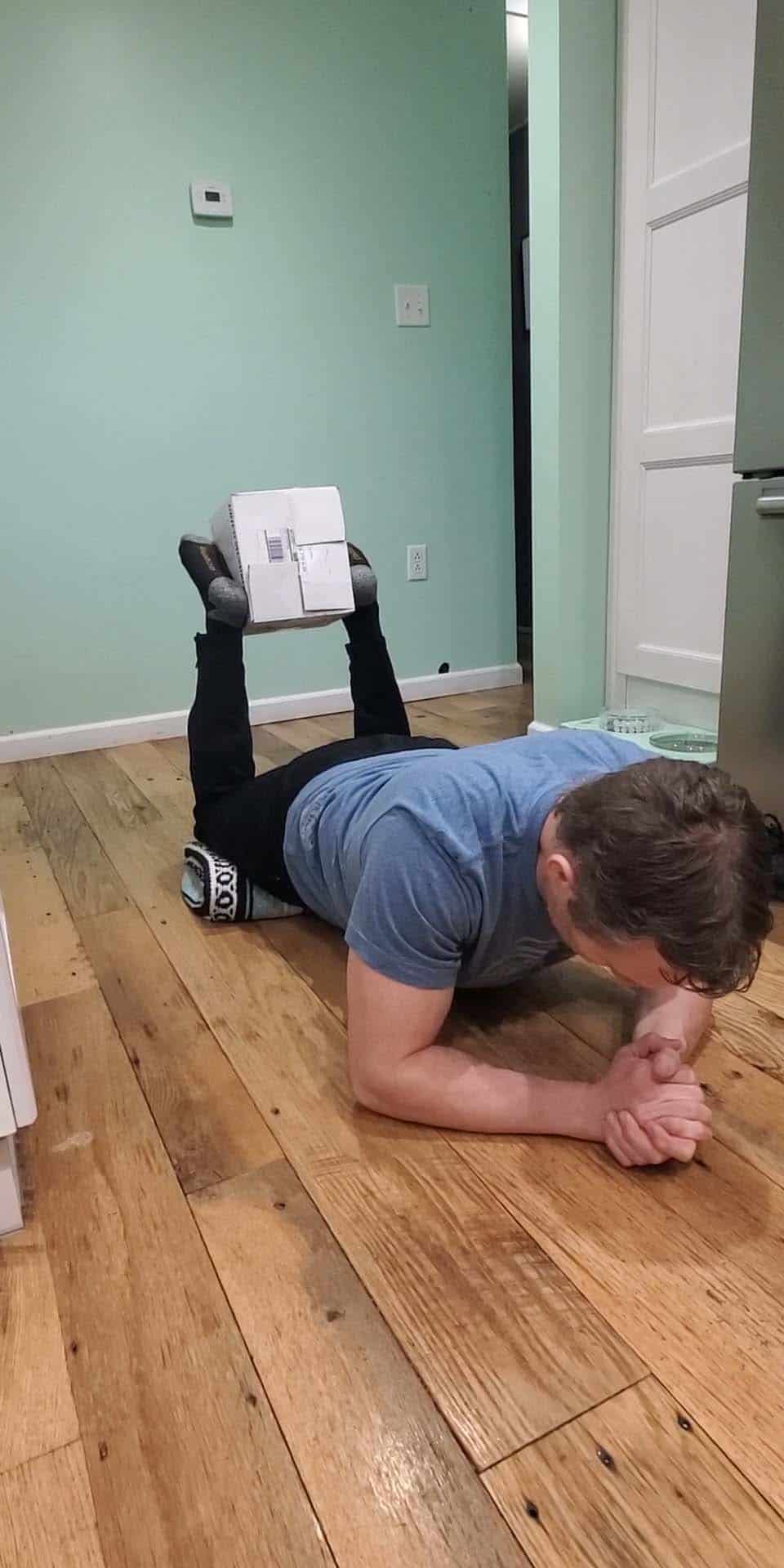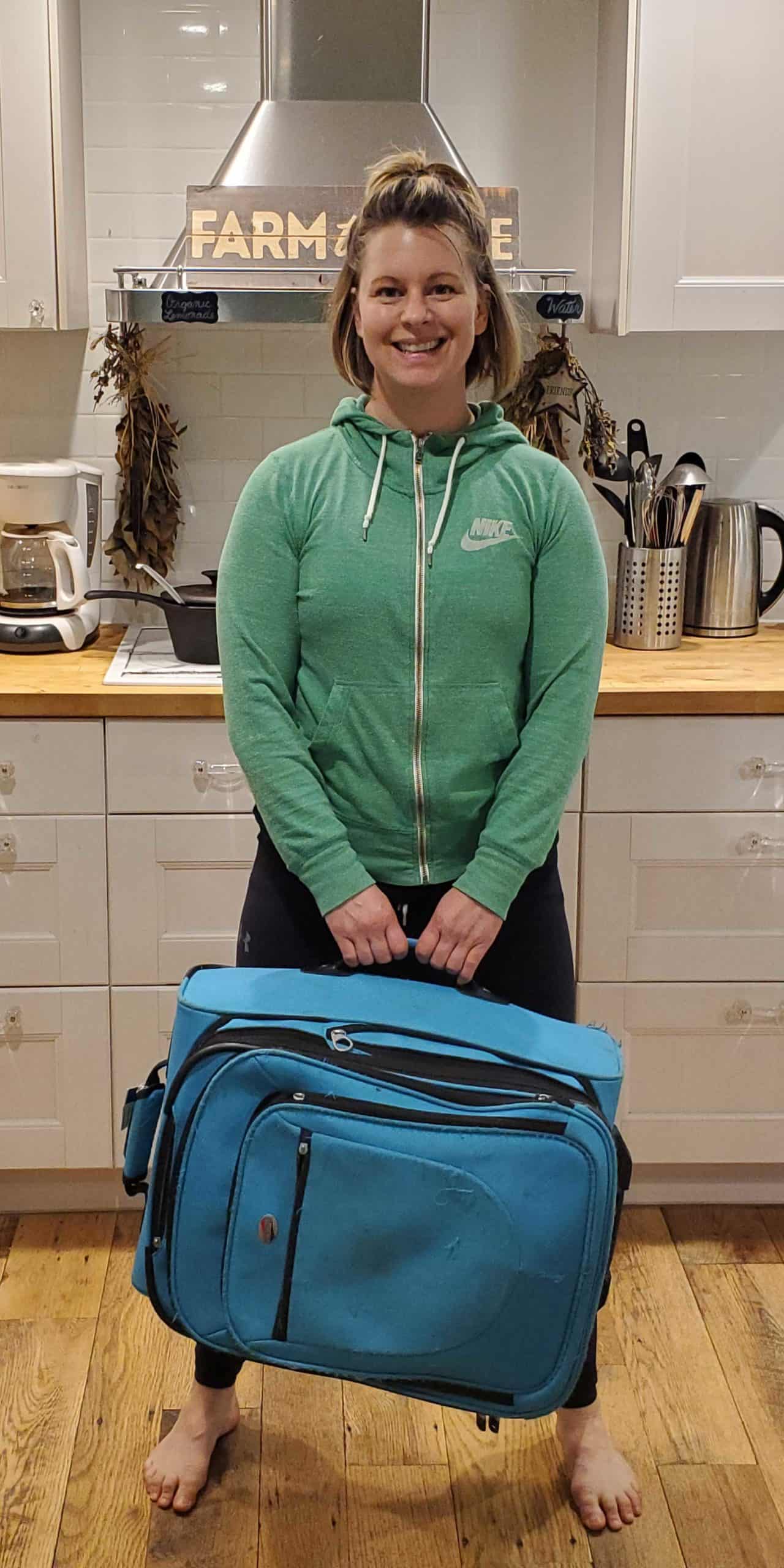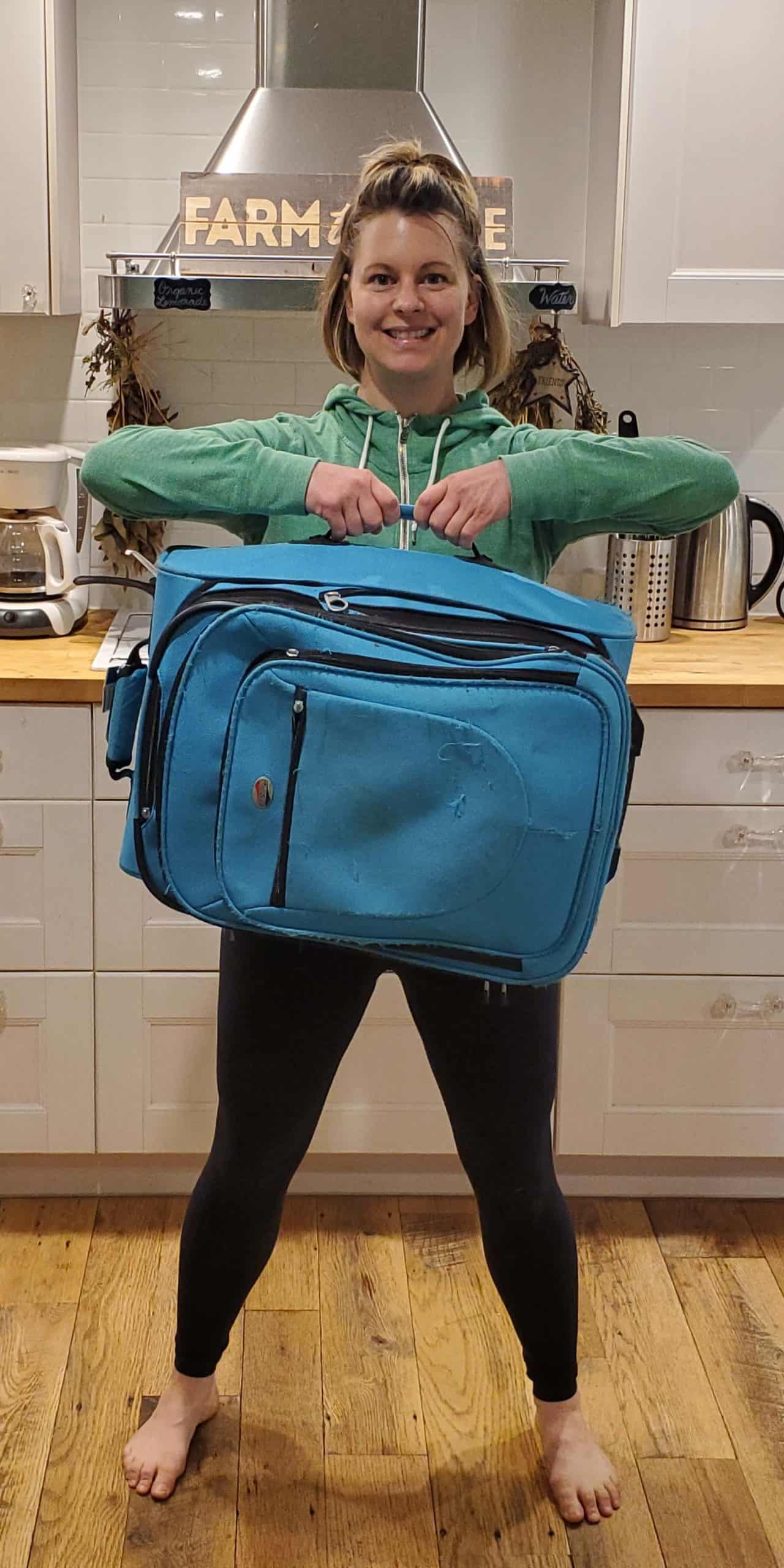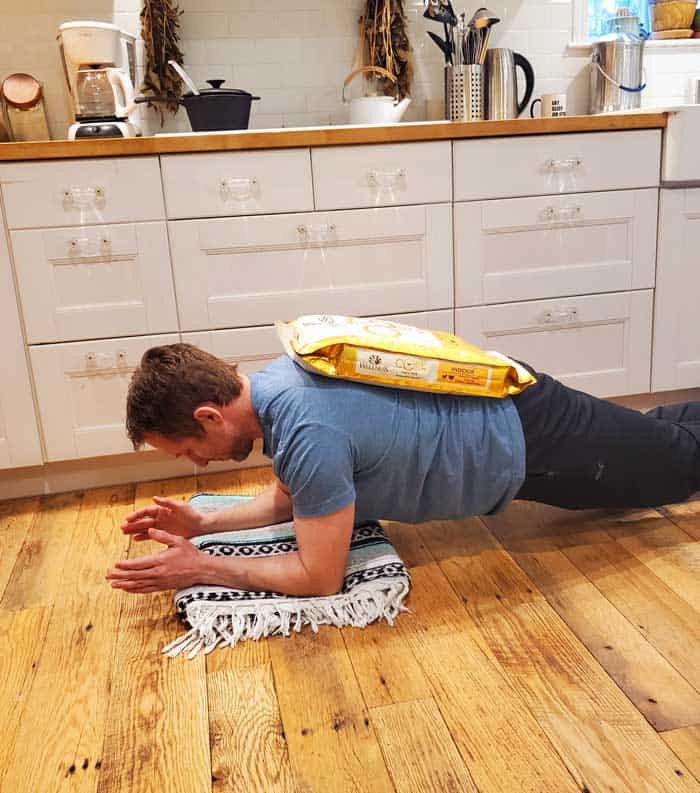Articles, In the Press, Internal Medicine, Resources, Tiffany Cruikshank, Yoga Medicine® News
How to Exercise During a Pandemic: Your COVID-19 Workout Questions Answered
By Leah Zerbe for Dr. Axe.
If you’ve been curled up on your couch on a steady diet of wine, cable news and coffee, and/or your step count is barely escaping triple digits, it’s time for a reset. But maintaining, let alone starting, a fitness routine during the current COVID-19 situation poses unique challenges. Mainly: how to exercise during a pandemic.
And hey, if you’re kicking yourself for not ordering that Peloton bike over the winter, don’t beat yourself up. There are very efficient, effective ways to work out at home with zero gym equipment by simply using things lying around your house, regardless of your current state of fitness.
But first, here’s a quick pep talk on why it’s so essential to figure out a home exercise regimen that’s right for you, even at a time when gyms and many parks are closed and fitness as usual is on hold.
The Exercise-Immune System Connection
A healthy immune system is on everyone’s mind right now. And while there’s no shortage of information about the best herbs, teas and foods for immune health, what about the best types of exercise to bolster our bodies’ first line of defense against infection?
The research literature is clear when it comes to the benefits of exercise on the immune system. Regular, moderately intense endurance exercise improves immune responses. This includes things like brisk walking, slow jogging, climbing stairs and dancing. The speed at which you perform these exercises is different for everyone because we’re all at different fitness levels.
But the idea is moderate-intensity exercise means you’re moving in a way that burns off three to six times as much energy every minute compared to just sitting and watching Netflix, reading or watching your plants grow.
How do we know we’re in the moderate zone? Here are four easy options to determine when you’re there:
1. Use the Talk Test
You can talk, but not sing, when you’re hitting the moderate-intensity zone.
2. Use Simple Math to Estimate
Aim to hit a target heart rate between 64 and 76 percent of your maximum heart rate. To estimate your max heart rate and moderate intensity based on your age, use this easy formula:
220 – your age = your maximum heart rate (beats per minute)
For example, I’m 38, so my moderate-intensity range would be between about 116 and 138 beats per minute, determined by:
- Max heart rate: 220 – 38 years = 182 beats per minute (bpm)
- Low-end of moderate intensity target: 182 x 0.64 = 116
- High-end of moderate intensity target: 182 x 0.76 = 138
3. Use the Borg Scale of Perceived Exertion Scale
Starting at 6 (the easiest) and going all the way up to 20 (sprinting all out like a tiger’s nipping on your new pair of Brooks), you’ll want to hit exertion cues (“fairly light” to “somewhat hard”) in the middle for moderate intensity endurance training.
So think more like booking it through the grocery store with your cart to avoid all of those people without masks to brisk-paced walking or slow jogging, but not something that puts you completely out of breath and unable to hold a conversation.
4. Use Technology
Some fitness devices are geared toward your intensity zones, so just make sure you calibrate your device correctly and you understand those zones to make sure you’re getting accurate readings.
Now, when it comes to exercise and immunity, less is known about intense exercise and strength training because this body of literature isn’t as established. After all, compared to other sciences, exercise science is relatively new and there’s a lot to learn.
But in general, there appears to be no harm in working out more intensely, in moderation, and tapping into the benefits of strength training when it comes to immune system health, explains Jeffrey A. Woods, PhD, professor of kinesiology and community health and associate dean for research at the University of Illinois at Urbana-Champaign. “Most studies show either no effect or a slight improvement in immunity. So continue to exercise. Do not let this pandemic stop you from gaining the benefits of exercise.”
That said, there are some basic rules to live by when trying to figure out how to exercise during a pandemic.
10 Rules on How to Exercise During a Pandemic
1. Don’t Start an Intense Training Regimen if You’re Out of Shape – Build Up Slowly
Maybe you’re one of the millions laid off. Or working from home. Or waiting for your business to open back up. Whatever the case, you may find yourself with more free time at home.
Work out. But be moderate. I know, I know, selling the idea of moderation is hard. Americans love the idea of 15-day fixes and “instant results.” But one of the No. 1 mistakes in exercise is to go too hard too soon. Give your body time to adapt and lower your risk of burnout and injury by easing into it.
Remember, there are always peaks and valleys when it comes to motivation levels, so don’t try to sprint a marathon. Be in it for the long game. Shoot for 30 to 60 minutes of moderate-intensity exercise at least five days a week, but start with less if you have to. The main idea is to get moving. We know exercise releases endorphins and helps reduce symptoms of depression and anxiety. Be inspired, start slowly and build up.
2. Save Group/Contact Sports for Another Time
News alert. Now isn’t the time for neighborhood pickup games or sneaking into your neighbor’s basement for close-contact, live training with your Brazilian jiu-jitsu buds. Understanding that even asymptomatic people can spread COVID-19, and it can strike people of all ages, including people who are otherwise in good health, makes this one a no-brainer.
“It would be beneficial during these times to avoid modes of exercise that puts you in close quarters with large groups of people. This would include all forms of close-quarter martial arts training, including boxing, wrestling and Brazilian jiu-jitsu,” says National Academy of Sports Medicine spokesperson Prentiss Rhodes, CPT, CES, PES, CSCS. “There are plenty of solo drills that you can do to stay fit, such as shadow boxing, various rolls and ground mobility drills like shrimping and bridging.”
The idea is to minimize physical contact with others right now to help prevent overwhelming the healthcare system. Many people are doing this, and where they are, it’s working. It’s also important not to rush back into close-contact exercise with others outside of your household, especially given the history of the 1918 influenza pandemic, which was much deadlier in its second wave.
3. Avoid “Slipstreams” When It Comes to Exercising Outside
While getting outside to exercise can certainly be beneficial, experts say it’s best to stick to solo runs and rides … or stick to exercising in a pack of people from your own household for now — and away from high foot-traffic areas to reduce exposure.
If you’re wondering about getting together with Friends for group runs … well, this isn’t the time for that. While the patchwork of stay-at-home restrictions across different states may seem confusing, and most do allow for outdoor exercise, fitness experts say it is best overall to avoid getting together in groups with people from different households to workout together.
Recent preliminary research looking at “slipstreams,” the spray of fluid in the region behind a moving person, actually went viral. Using computer simulation, Belgian researchers’ early findings suggest that the often recommended six-foot physical distancing rule may not be enough to prevent virus spread from one person to another during outdoor exercise.
To be clear, the researchers released the “white paper” findings early before peer review and has faced some criticism for that. But it is an interesting point to consider. When we are running and cycling, do we leave a path of potential transmission behind and around us?
Here’s what Woods, also a spokesperson for the American Collage of Sports Medicine, says:
There is very little research on this to make firm conclusions at the moment, but the physics makes sense, so I would recommend staying out of slipstreams of people while exercising especially until we know more and the pandemic eases. If you are moving at higher speeds, the aerosolized viral particles spread in the air farther before dropping to the ground. If you are behind someone moving fast — running, cycling — or there is high winds, there is increased risk and distances between people should be increased.
This isn’t to incite fear, but the science is interesting and something to consider. The truth is, we just don’t know fully how this virus behaves yet. So I like the way Bicycling’s Selene Yeager put it:
In the end, the advice still stands: Stay home as much as you can. Wash your hands often. Ride and run solo, striving for as much physical distance as you can from others — but definitely at least six feet. Wear a [mask] if you’re going to be in highly trafficked areas. If you feel at all sick stay home.
While getting together with folks outside of your household may be safe if social distancing is maintained, the optics of it aren’t good right now. “I would not encourage this, as it is a slippery slope to break the rules,” Woods says, noting one exercise mistake he’s seeing is people coming into close contact with people outside of their own households.
5. Resist the Urge to Overtrain
“For people who exercise regularly, continue to do so, taking precautions,” Woods says. “If this changes your routine, make a new one. You may find it energizes your workouts, finding more creative ways to resistance train, using body weight with objects in the home.”
For people who may be immune compromised due to type 2 diabetes, living with cancer, high blood pressure and so on, Woods recommends starting out with light to moderate endurance activities like walking and light stretching and lifting, noting it is best to check in with a healthcare provider by phone. “But it is very important for high COVID-19 risk groups like this to practice good public health hygiene and social distancing and making sure they don’t overdo it.”
More intense, prolonged exercise is likely low-risk for people accustomed to it, but there is some evidence to suggest that highly intense or prolonged exercise can reduce immune function, especially if performed by someone not accustomed to it.
Woods says signs you’re doing too much, too soon and in overtraining mode include:
- Fatigue in response to normally easy exercise
- Mood disturbances
- Failure to recover from mild exercise
- Change in heart rate, including low heart rate
- Lack of refreshing sleep
Other indicators include increased soreness and joint pain, chronic fatigue or exhaustion, feeling more thirsty than usual, changes to your menstrual cycle and digestive issues.
6. Get the Kids Onboard
For moms like Ali Lockey, exercise has always been a bonding experience for her and 20-month-old daughter Brynnley. Ali remained active throughout pregnancy, and when she started training again after giving birth, Brynnley tagged along to her training sessions at the gym, where she quickly became known as her mom’s “personal trainer.”
With trips to the training studio on hold, Ali and Brynnley are staying fit with at-home workouts, tuning in remotely with their real trainer.
The key to staying consistent with at-home workouts with little ones around, Ali says, is keeping things light and fun. Don’t take yourself too seriously. And definitely use your child, when it’s safe, if you need a little added resistance!
If possible to do safely with restrictions in place, Rhodes stresses getting outside and exercising in open air. “The importance of this can’t be underestimated. Adding sun and fresh air to your workouts can have a positive effect on your mood.”
Another tip? “Think about unstructured play as a form of exercise,” he adds. “Playing games like freeze tag or an active game of animal charades with kids or keep-away with pets is a great way to sneak some cardio in while also bonding.”
7. Get Creative
Instead of dropping much-needed cash on new workout gear that could be backordered for weeks, use what you’ve got. You likely already know about using soup cans as weights, but here are some ways to improvise with things likely in and around the house … and don’t worry, I’ll show you how to use them in a workout below.
- Suitcases
- Frisbees
- Paper plates
- Bags of dry pet food
- Rice bags
- Walls
- Countertops
- Jugs of milk/detergent/bulk cleaner
- Your kid or other humans living in your home
- Tennis balls
- Broom/mop handle
- Office chairs
- Barstools
- You! You didn’t think you’d get away without doing bodyweight exercises, did you?
8. Don’t Forget Other Wellness Necessities
While learning how to exercise during a pandemic is important, your recovery is just as important, says Rhodes. He recommends:
- Sleeping at least eight hours
- Eating a diet balanced for your specific needs, including plenty of fruits and vegetables because they provide many co-factors necessary to drive the chemical reactions in the body
- Drink plenty of fluids
- Practice mindfulness activities to reduce additional life stress
9. Use the ‘FITTE’ Approach
While there is no one, “best” exercise plan, you should put a little planning into it for long-term success. Rhodes says a good approach would be to follow the FITTE principle which stands for: Frequency, Intensity, Time, Type and Enjoyment.
For example, you could use the principle in the following way. (And seriously, put this down on paper, and then schedule it into your calendar for a much higher shot at success.)
- Frequency: I will train two to three days per week.
- Intensity: I will train at a moderate exertion level or at 70 to 80 percent of my 1 RM (repetition max)
- Time: 60 minutes
- Type: Barbells, bodyweight exercise, various cardio exercises
- Enjoyment: Circuit training, interval training, etc.
“Do not overlook the enjoyment part of the principle, as it will keep you motivated and on track with your routine,” Rhodes warns. “In short, if you don’t like running for cardio, don’t run. You’ll dislike it and eventually quit your program.”
When etching out your plan, however, opt for some strength training two to three days per week and cardio training three to five days per week.
10. Consider Teaming Up with a Local Exercise Expert
Lastly, if you are looking for motivation and an expert to help you on your journey and have the means to do it, know that many certified personal trainers are taking their expertise online using Facetime, Zoom and other one-on-one digital connect points to help you hit your goals.
Look for trainers certified through the National Academy of Sports Medicine, American Collage of Sports Medicine or the National Strength and Conditioning Association. An advanced degree in exercise science, kinesiology or a related field is a major plus.
If funds are tight, consider teaming up with someone in a different household and splitting the training session while meeting during the same time slot virtually, if your trainer’s up for it.
In-Home Pandemic Workout Ideas
Ready to get to work? OK. Head over to that pile of laundry on your dining room table, dig out your favorite workout pants and hey, don’t worry if they’re covered in cat hair. Mine are, too. Let’s go!
Corrective/Mobility Work Ideas
1. Self-Myofascial Release (SMR) Using a Rolling Pin
With many folks more sedentary than ever, it’s important to work some self-myofascial release into your fitness game plan to help work out muscle imbalances commonly seen in people sitting a lot or spending a lot of time behind a screen.
Foam roller exercises are great for this, but if you don’t have a roller handy, there are ways to improvise. If you have a rolling pin handy, it can be great tool to work through the calves, an area that tends to get tight on most folks and can impact your squat form and low back health.
Sitting on the floor, place one calf over the rolling pin. If you need extra weight, cross your other leg over the leg you’re rolling.
More around until you find a tender spot and stay there for 30 seconds. Avoid rolling quickly back and forth and instead keep pressure on the spot for at least 30 seconds. If you feel intense pain, pins and needles or burning, stop immediately.
SMR may not be appropriate if you’ve got uncontrolled high blood pressure, are pregnant, dealing with a new injury, osteoporosis or skin infection or cancer, so always check with your go-to healthcare expert if you’re dealing with any specific health issues.
2. SMR Using Tennis Balls
For those trigger point “knots” — those nooks and crannies in the upper back, pecs and TFL muscles, I use Recovery Rounds by Rad Roller created by Yoga Medicine’s Tiffany Cruikshank. The same principle of applying pressure to the tender spot for 30 seconds to a minute before releasing works with with this ball-type recovery tool, too.
But even a tennis ball can get the job done and can bring great relief to the upper traps, which tend to get super tight due to irregular (and common) shallow chest breathing patterns and spending too much time slouched in front of a screen.
After you use SMR on a particular area, be sure to stretch it out with 30-second static stretch holds, too, before starting your workout.
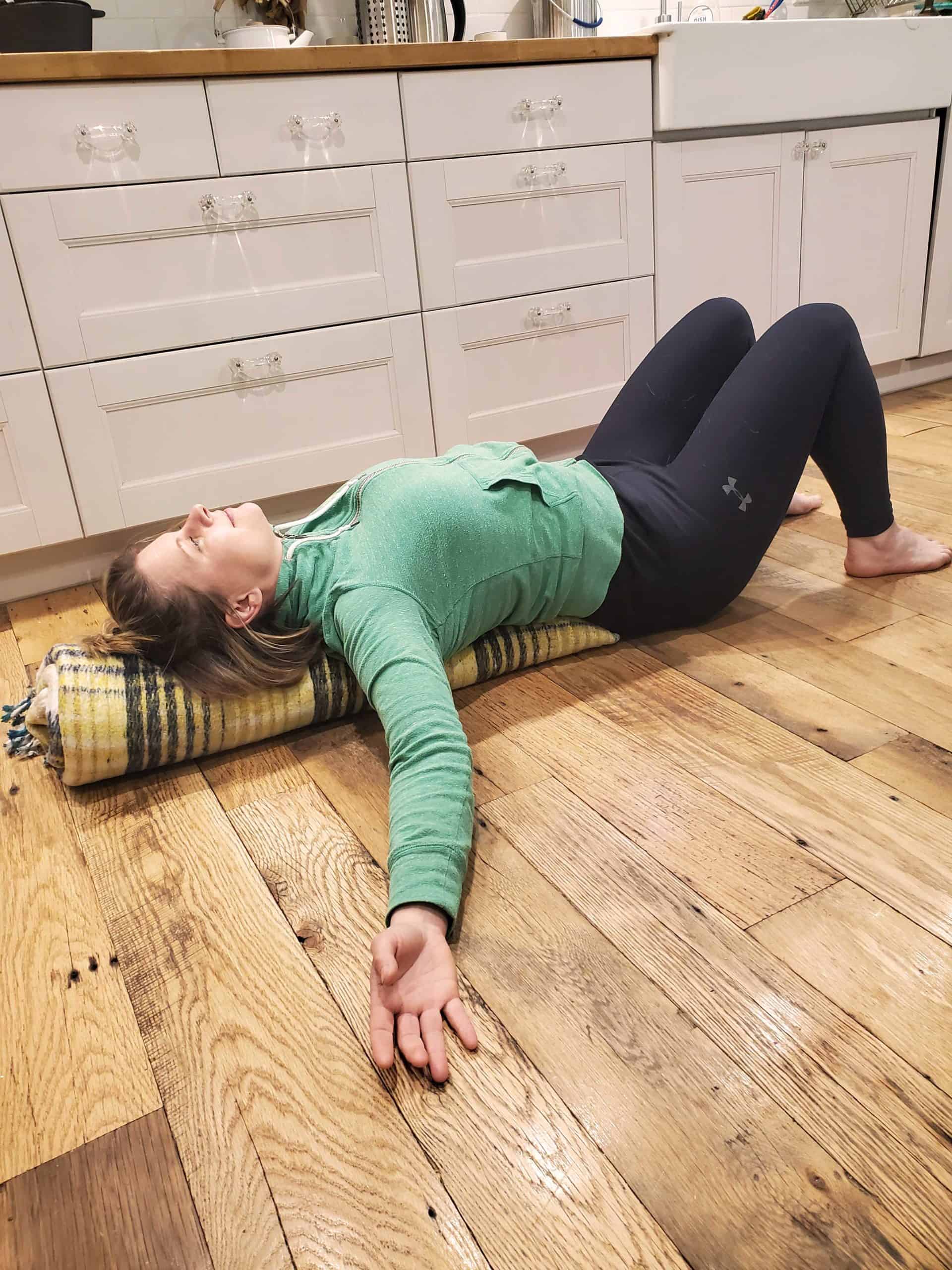 3. Supported Fish Pose with Rolled Up Blanket
3. Supported Fish Pose with Rolled Up Blanket
This is great restorative yoga pose for the end of a workout, especially one involving lots of push-ups. But it’s also nice to start out in supported fish for a few minutes to open up the typically tight chest muscles, including the pecs and intercostal rib muscles, and working through the thoracic spine area.
To set up, roll a blanket the long way and place your buttocks on the floor at the end of the cylinder-shaped, rolled-up blanket. Then, simply lie down, aligning your spine on the blanket, making sure your head is also supported and not hanging off the other end. Take the arms out to the side, resting on the floor with the palms up.
Or, another option here is to take the arms into a cactus or goal post position, with the back of the hands resting on the floor or a yoga block or pillow for support.
Equipment-Free Exercise Ideas
Get started by activating typically underactive muscles like the glutes and core. Start slowly and work up to get your muscles moving and heart rate elevated.
This all depends on your current fitness and mobility levels, so go at your own pace and listen to your body. Skip what doesn’t feel supportive in your body and work up to more reps and sets and duration as your fitness increases. Some in-home ideas include: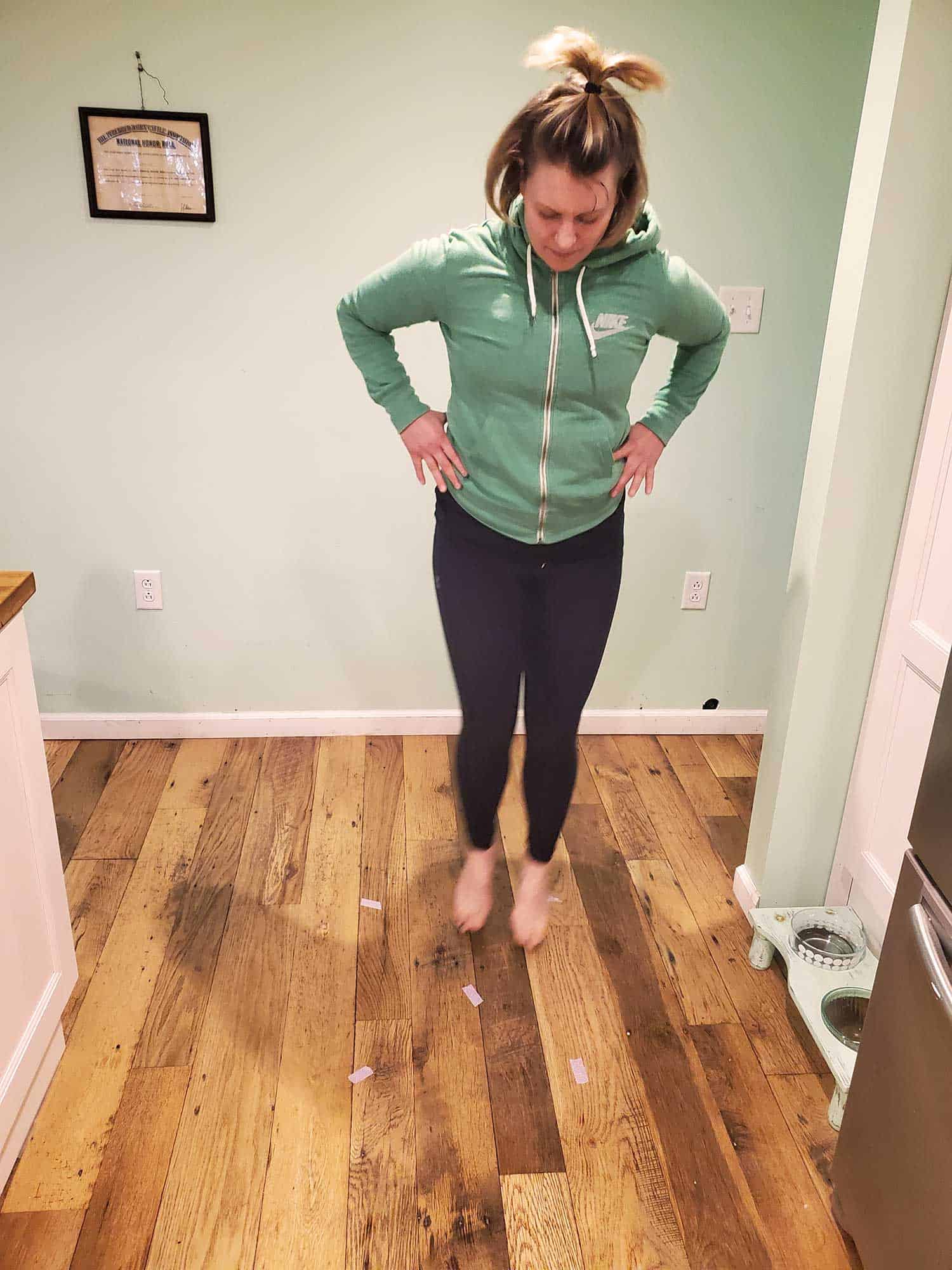
- Butt kicks
- Cat/cow pose
- Marching/running in place
- Jumping jacks and other burst training at home exercises
- Inch worms
- Plank exercise variations
- V-ups and other ab workout options
- Butt workout exercises like sumo squats, donkey kicks, hip raises and jump squats
- Chair exercises for seniors
- Dot drill: Place a few pieces of tape on your floor and hop or step to the different spots. Be sure it isn’t super strong tape, and don’t let it on for long, or it could strip the finish off of your flooring.
At-Home Strength Training Ideas
1. Using Frisbees/Paper Plates as Exercise Sliders
To work the hamstrings, you can place frisbees on paper plats under your heels, and keeping the core engaged and strong, bridge up, slide heels away from you and then pull them back in toward your butt.
In a new way to work the core, you can use your frisbees and/or paper plates starting in table top position (on hangs and knees with wrists stacked under shoulders and knees stacked under hips), and then slowly sliding forward, being sure not to overextend your lower back before returning to tabletop position.
For an adductor workout, try this slider exercise:
Start with one foot on a paper plate or frisbee.
Keeping the core strong and making sure knees aren’t caving over toes, slide the plate out to the side, press down and pull back to center.
2. Hamstring Curl with a Box
This 2-pound box of dehydrated shiitake mushrooms was the perfect light weight for this at-home hamstring curl.
Got an office chair on wheels? Another way to work the hamstring is simply sitting in your chair on an uncarpeted surfaced and using just your legs to pull yourself forward.
3. Dust Off Your Luggage
You may not be going on vacation anytime soon, but you can certainly use suitcases in your at-home workout routine. One easy way is to incorporate it into an upright row, as you see below:
Adding Extra Weight
If you exercise at home with a toddler, you know, if done safely, they can make a great way to add resistance to an exercise. My husband, Greg (also a trainer and certified strength and conditioning specialist through NSCA), and I only have three cats, so we rely on larger bags of dry cat food instead!
Try using these if you need a little added weight for things like planks and bridges. Just be prepared for your pets to swarm you, thinking it’s dinner time.
Cool Down/Breath Work
Finally, finish off your at-home workout with the following in order to flush lactic acid out of your muscles and settle back into your day with a tired but inspired body and mind!
- Repeat Supported Fish with a Blanket
- Stretch calves, TFL and pecs (hold each for 30 seconds)
- Gentle yoga for lymph flow to improve your immunity
- Crocodile for diaphragmatic breathing training and stress relief














